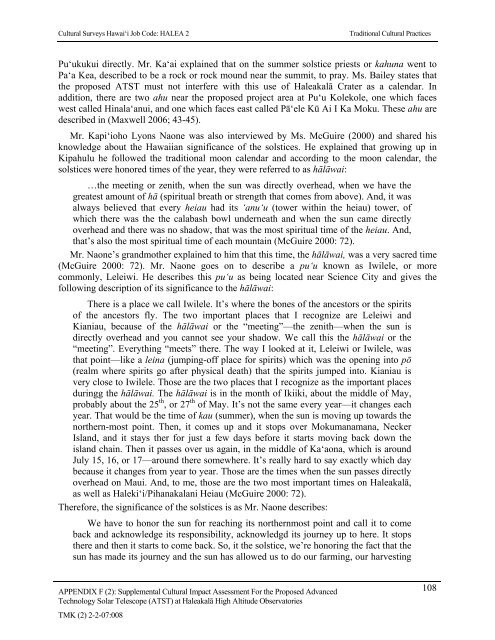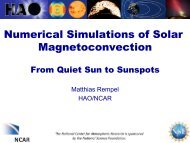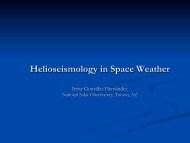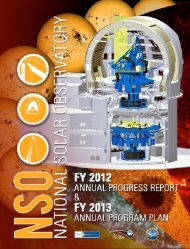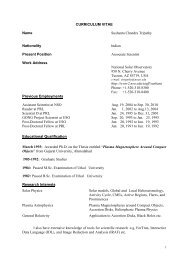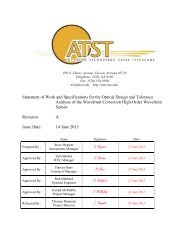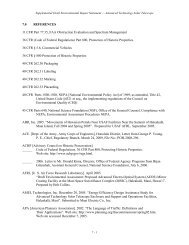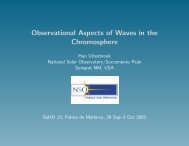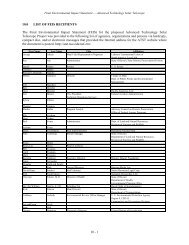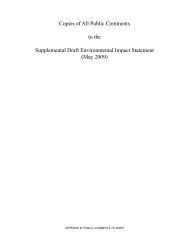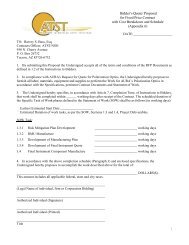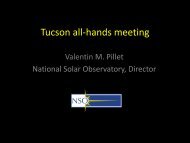F2 - ATST
F2 - ATST
F2 - ATST
Create successful ePaper yourself
Turn your PDF publications into a flip-book with our unique Google optimized e-Paper software.
Cultural Surveys Hawai‘i Job Code: HALEA 2Traditional Cultural PracticesPu‘ukukui directly. Mr. Ka‘ai explained that on the summer solstice priests or kahuna went toPa‘a Kea, described to be a rock or rock mound near the summit, to pray. Ms. Bailey states thatthe proposed <strong>ATST</strong> must not interfere with this use of Haleakalā Crater as a calendar. Inaddition, there are two ahu near the proposed project area at Pu‘u Kolekole, one which faceswest called Hinala‘anui, and one which faces east called Pā‘ele Kū Ai I Ka Moku. These ahu aredescribed in (Maxwell 2006; 43-45).Mr. Kapi‘ioho Lyons Naone was also interviewed by Ms. McGuire (2000) and shared hisknowledge about the Hawaiian significance of the solstices. He explained that growing up inKipahulu he followed the traditional moon calendar and according to the moon calendar, thesolstices were honored times of the year, they were referred to as hālāwai:…the meeting or zenith, when the sun was directly overhead, when we have thegreatest amount of hā (spiritual breath or strength that comes from above). And, it wasalways believed that every heiau had its ‘anu‘u (tower within the heiau) tower, ofwhich there was the the calabash bowl underneath and when the sun came directlyoverhead and there was no shadow, that was the most spiritual time of the heiau. And,that’s also the most spiritual time of each mountain (McGuire 2000: 72).Mr. Naone’s grandmother explained to him that this time, the hālāwai, was a very sacred time(McGuire 2000: 72). Mr. Naone goes on to describe a pu‘u known as Iwilele, or morecommonly, Leleiwi. He describes this pu‘u as being located near Science City and gives thefollowing description of its significance to the hālāwai:There is a place we call Iwilele. It’s where the bones of the ancestors or the spiritsof the ancestors fly. The two important places that I recognize are Leleiwi andKianiau, because of the hālāwai or the “meeting”—the zenith—when the sun isdirectly overhead and you cannot see your shadow. We call this the hālāwai or the“meeting”. Everything “meets” there. The way I looked at it, Leleiwi or Iwilele, wasthat point—like a leina (jumping-off place for spirits) which was the opening into pō(realm where spirits go after physical death) that the spirits jumped into. Kianiau isvery close to Iwilele. Those are the two places that I recognize as the important placesduringg the hālāwai. The hālāwai is in the month of Ikiiki, about the middle of May,probably about the 25 th , or 27 th of May. It’s not the same every year—it changes eachyear. That would be the time of kau (summer), when the sun is moving up towards thenorthern-most point. Then, it comes up and it stops over Mokumanamana, NeckerIsland, and it stays ther for just a few days before it starts moving back down theisland chain. Then it passes over us again, in the middle of Ka‘aona, which is aroundJuly 15, 16, or 17—around there somewhere. It’s really hard to say exactly which daybecause it changes from year to year. Those are the times when the sun passes directlyoverhead on Maui. And, to me, those are the two most important times on Haleakalā,as well as Haleki‘i/Pihanakalani Heiau (McGuire 2000: 72).Therefore, the significance of the solstices is as Mr. Naone describes:We have to honor the sun for reaching its northernmost point and call it to comeback and acknowledge its responsibility, acknowledgd its journey up to here. It stopsthere and then it starts to come back. So, it the solstice, we’re honoring the fact that thesun has made its journey and the sun has allowed us to do our farming, our harvestingAPPENDIX F (2): Supplemental Cultural Impact Assessment For the Proposed AdvancedTechnology Solar Telescope (<strong>ATST</strong>) at Haleakalā High Altitude ObservatoriesTMK (2) 2-2-07:008108


